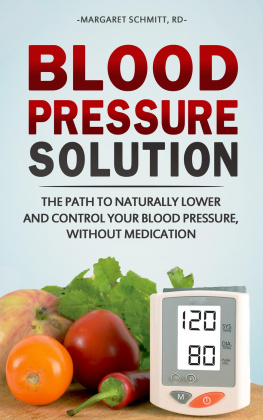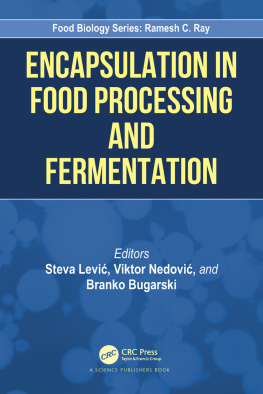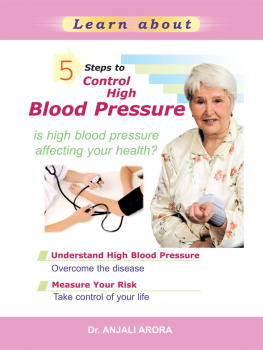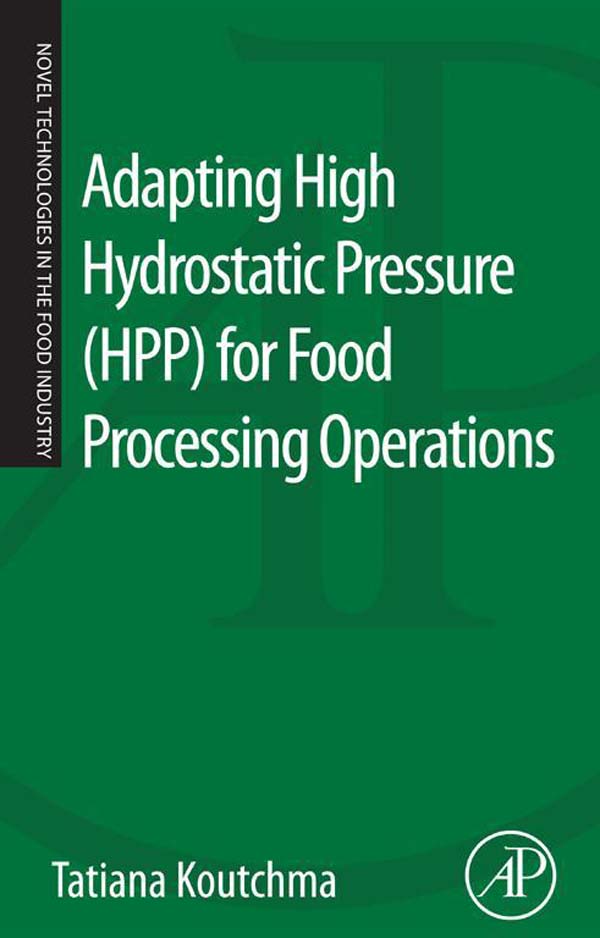Table of Contents
List of tables
- Tables in Chapter 2
- Tables in Chapter 4
- Tables in Chapter 5
- Tables in Chapter 8
List of illustrations
- Figures in Chapter 4
- Figures in Chapter 6
- Figures in Chapter 7
- Figures in Chapter 8
Landmarks
Table of Contents
Adapting High Hydrostatic Pressure (HPP) for Food Processing Operations
Tatiana Koutchma, PhD
Agriculture and Agri-Food Canada, Guelph Food Research Center, Guelph, ON, Canada
Novel Technologies in the Food Industry

Copyright
Academic Press is an imprint of Elsevier
32 Jamestown Road, London NW1 7BY, UK
525 B Street, Suite 1800, San Diego, CA 92101-4495, USA
225 Wyman Street, Waltham, MA 02451, USA
The Boulevard, Langford Lane, Kidlington, Oxford OX5 1GB, UK
First published 2014
Copyright 2014 Elsevier Inc. All rights reserved
No part of this publication may be reproduced or transmitted in any form or by any means, electronic or mechanical, including photocopying, recording, or any information storage and retrieval system, without permission in writing from the publisher. Details on how to seek permission, further information about the Publishers permissions policies and our arrangement with organizations such as the Copyright Clearance Center and the Copyright Licensing Agency, can be found at our website: www.elsevier.com/permissions
This book and the individual contributions contained in it are protected under copyright by the Publisher (other than as may be noted herein).
Notices
Knowledge and best practice in this field are constantly changing. As new research and experience broaden our understanding, changes in research methods, professional practices, or medical treatment may become necessary.
Practitioners and researchers must always rely on their own experience and knowledge in evaluating and using any information, methods, compounds, or experiments described herein. In using such information or methods they should be mindful of their own safety and the safety of others, including parties for whom they have a professional responsibility.
To the fullest extent of the law, neither the Publisher nor the authors, contributors, or editors, assume any liability for any injury and/or damage to persons or property as a matter of products liability, negligence or otherwise, or from any use or operation of any methods, products, instructions, or ideas contained in the material herein.
Library of Congress Cataloging-in-Publication Data
A catalog record for this book is available from the Library of Congress
British Library Cataloguing-in-Publication Data
A catalogue record for this book is available from the British Library
ISBN: 978-0-12-420091-3
For information on all Elsevier publications visit our website at http://store.elsevier.com/

Abstract
The publication targets a broad audience of food industry professionals, government scientists, academia personnel, regulators, and graduate students, who are interested in exploring high hydrostatic pressure technology or HPP for food applications. The benefits of HPP for nonthermal treatment of different groups of raw and finished products in the different categories of juices, fruits and vegetables, meat and fish products are presented. After introduction of the basic principles of HPP technology, the focus has been made on discussing specific pressure-induced effects on foods properties and packaging that need to be known before specifying HPP process and equipment. This will include the discussion of phenomena of adiabatic temperature increase, HPP in-container principle and requirements for plastic materials, critical process and product parameters, and how they can affect microbial efficacy of HPP treatments. The brief reviews of reported studies for HPP treatments of commercially produced foods are presented followed by the detailed information regarding manufacturers of HPP processing equipment and consideration to take into account when installing HPP unit. Development of HPP preservation process, energy savings, environmental aspects and regulatory status around the globe in North America, EU, New Zealand, and Australia are discussed in order to assist the end users to learn about recent trends and to give practical recommendations to accelerate the transfer of accumulated HPP knowledge in commercial operations.
Chapter 1
Introduction
The benefits of hydrostatic pressure processing (HPP) technology are briefly introduced for the range of food applications. Geography of HPP products market and products categories are discussed along with the perspectives of the HPP equipment manufacturing. The need in practical recommendation and steps is justified to accelerate the HPP technology transfer.
Keywords
High hydrostatic pressure; novel technologies; non-thermal; preservation; shelf-life extension; natural products
The benefits of hydrostatic pressure processing (HPP) technology are briefly introduced for the range of food applications. Geography of HPP products market and products categories are discussed along with the perspectives of the HPP equipment manufacturing. The need in practical recommendation and steps is justified to accelerate the HPP technology transfer.
1.1 HPP Benefits and Global Market
High hydrostatic pressure processing (HPP) is a novel technique that emerged in food production within the last decade and more recently for pharmaceutical and medical applications. Key advantages of HPP such as instant and homogenous transmittance of pressure in the treated product and the possibility of processing at ambient temperatures represent an attractive powerful tool to implement mild postpackaging processing for a broad range of foods. Pathogens inactivation and shelf-life extension in ready-to-eat (RTE) meats are, apparently, the HPP applications that have made the technology known and accepted in the food industry. Theoretically pressuretemperature operational conditions for HPP treatment of foods may range from 300 to 1000 MPa at 20C to 121C, depending on the process and the nature of the food resulting in the processes such as sterilization, pasteurization, or shelf-life extension with added value.
HPP as a clean label technology has found a growing acceptance in the food industry for producing high-quality foods. The recent market research study reported that by 2013 the global HPP products market has achieved $3 billion. Fruit and vegetable products are the largest product market for HPP, followed by meat products and then seafood and fish products. North America dominates the global HPP products and equipment market, with the United States as the largest market. United States as a leading adaptor of the technology is followed by parts of Europe (Spain, Germany, France, The Netherlands, Great Britain, and Italy), Asia (Japan, China, Taiwan), Australia, and New Zealand. In 2013, the estimate of HPP equipment market was $350 million and is projected to grow at 11% Compound Annual Growth Rate (CAGR) for the next 5 years.









